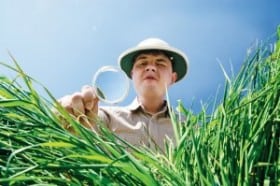How to Identify the Grass in Your Lawn

Texas is doing pretty well on the housing market front compared to other states. In Austin, people are buying & selling their houses like it’s going out of style. Perhaps you are one of the many Texans who recently moved to a new home. If so, you might be wondering what type of grass is growing in your yard.
There are dozens of grass varieties out there, but don’t let that discourage you. In today’s post, we’ll share some steps to help you identify what’s growing.
1. Identify your climate — By knowing what climate you’re in, you can eliminate certain varieties. Grasses are considered either “cool-season” or “warm-season” grasses based on how they perform in the climate in which they’re planted. If you live in Texas, you’re almost certainly looking at a warm-season grass variety like St. Augustine, Buffalo, Zoysia, or Bermuda.
2. Make observations — Get out on your lawn and take a few close-up pictures of the grass blades. Write down what you observe about the color, shape, texture, and height of any grass varieties you see. Is the blade light green or dark green? Skinny or wide? Rounded or pointed at the tip? Smooth or hairy? Shiny or dull? Tall or short? Use your notes to cross-check with a resource like The Lawn Bible or Aggie Turf’s identification guide.
3. Call in the experts — If your lawn is still a mystery, try calling a local lawn care professional, such as Real Green Pest & Lawn, or your local Ag Extension to help you identify your grass variety. You could probably even email a close-up photo and get the feedback you need.
Once you’ve identified the grass that’s in (or struggling to be in) your yard, it’s time to ask yourself if you’re happy with it. Your yard may be better suited to a different grass variety. The good news is, you can get a brand new lawn quickly when you lay fresh sod. At The Grass Outlet, we provide Texans with turfgrass that’s perfectly suited to our warm, humid climate. Shop from our online store or give us a call today.





